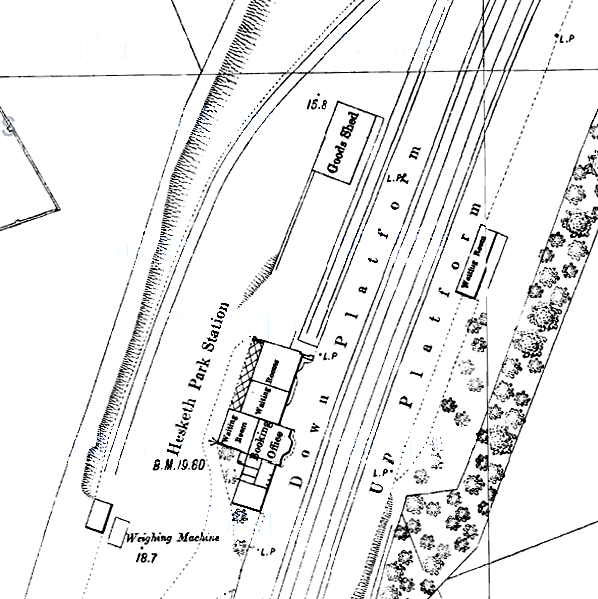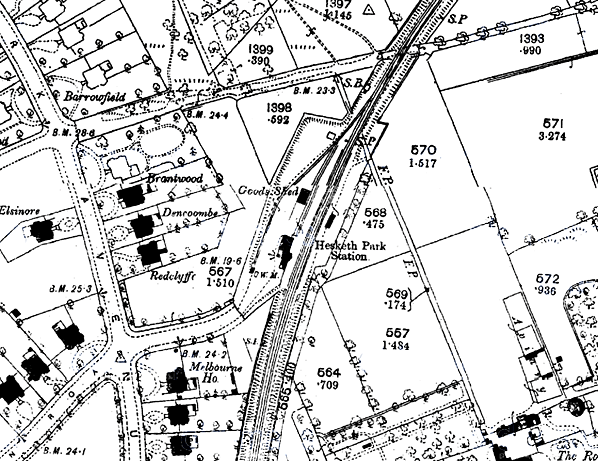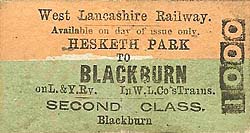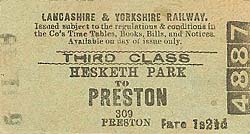
[Source:Tony Graham &
Paul Wright]
old7.jpg) Hesketh Park station seen in 1878 when it was still under the ownership of the WLR. At this time it did not have an adjoining stationmaster's house, and passengers crossed the line by means of a barrow crossing which can be seen in the picture. Also of interest is the goods yard seen in the background. Beyond the goods shed is the short-lived 1-road engine shed which opened on 19.2.1878 and closed on 18.5.1882.

 1890 OS town plan shows Hesketh Park station when still part of the WLR. At this time the station did not have a stationmaster's house or a footbridge.
 1894 1:2,500 OS map shows Hesketh Park station as it was before the northern end of the goods yard was altered and the level crossing to the north of the station was replaced with a pedestrian footbridge. The station itself had no footbridge at this time. The large, detached villas in substantial gardens immediately west of the station indicate the upper middle-class area that it served.The short-lived engine shed which closed in 1882 (see picture above) has already been demolished.
 1928 1,2500 OS map shows Hesketh Park station in its final form. The goods yard had been extended northwards, and a level crossing north of the station had been removed and replaced with a footbridge. Housing developments had been built along the western boundary of the goods yard. The station had a footbridge by this time, which was necessary as the line had been electrified using live rails in 1904. A station house had also been added.
old19.jpg) Electric services through Hesketh Park were operated by EMUs. This picture would suggest that there had been locomotive working. In fact it is a view of the LYR locomotive that was based at the Meols Cop car sheds c.1919 hauling an EMU, possibly because it had failed. The picture provides a good view of the station as it was in LYR days
old21.jpg) Hesketh Park station looking north-east from the footbridge in the 1930s. During this period the station was part of the LMS railway. The station’s goods shed can be seen to the left.
Copyright photo from John Alsop collection old22.jpg) Looking towards Preston from the down platform at Hesketh Park station in 1963. To the left can be seen the station building, and beyond it is the goods shed. In the distance is the
Henley Road footbridge. Copyright photo from Stations UK old18.jpg) Looking south-west at Hesketh Park station in August 1964. An LMS EMU of 1939 vintage (later class 502) has just called at the station on a Crossens to Southport Chapel Street service. The electric service had been introduced in 1904 and ended when the line closed on 6 September 1964. After leaving Hesketh Park the EMU would take the east fork at Roe Lane Junction and head to Meols Cop. After calling at Meols Cop it would reverse and continue to Southport Chapel Street.
old12.jpg) A Crossens to Southport Chapel Street EMU arrives at Hesketh Park station in 1964. A steam-hauled service to Preston had just departed and can be seen in the distance.
old15.jpg) A Stanier 2-6-4T No. 42555 accelerates its train away from the rain-sodden platforms of Hesketh Park, with the 16:14 Southport - Preston on 5 September 1964. Evidence can be seen, in the form of the open doors of the goods shed to the left of the down platform, that the depot and coal yard remained very much in business right up until the very end - this photograph being taken on the penultimate day, 5 September 1964. In fact, No. 88 target (9T88) had left Southport Goods at 09:50 that morning for Hesketh Park. After shunting the yard here, it would then have reversed and, if keeping with its normal itinerary, taken the north curve at Roe Lane Junction in order to shunt at Meols Cop sidings, on the Wigan line. A further reversal, this time traversing the Meols Cop south curve, eventually would have brought 88 Target back to Southport Goods, where wagons would be re-marshalled into later services, leaving the area via Burscough.
Copyright photo by Alan Castle old17.jpg) Hesketh Park station looking south-west from the Henley Road footbridge on 1 July 1965. Although passenger services had ceased by this date the station goods yard was still active. In the yard a Class 5MT (ex-LMS Black 5) locomotive number 45055 can be seen working a class J freight. It had worked the daily weekday coal train from Southport. After its loaded coal wagons were detached the locomotive returned with empties to Southport. 45055 was built in 1934 at Vulcan Foundry. It lasted until the end of steam and was withdrawn from 10D, Lostock Hall shed in August 1968. It was scrapped in February 1969 by Drapers of Hull.
Photo by B Barlow park12.jpg) Hesketh Park station looking north-east in the late 1960s.
park7.jpg) Looking south-west along the down platform at Hesketh Park station in late 1970s. Houses had already been built on the trackbed beyond the station.
park13.jpg) Looking north-east at a surviving lamp column from the footpath that linked Hesketh Park station's up platform to the Henley Road footbridge in 2011.
Photo by Steve Wright park12.jpg) The site of Hesketh Park station looking south-west in July 2011. The northern end of the platforms was roughly where the silver car can be seen on the driveway. The houses to the left are built on the trackbed; the up platform would have been behind them. The houses to the right occupy the site of the goods yard. The station building would have been just beyond the street lamp seen in the
middle of the picture. Photo by Paul Wright  Home
Page Home
Page
|






5.jpg)
.gif)

